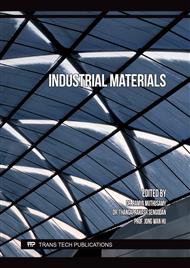[1]
M. Betti, A. Vignoli, Numerical assessment of the static and seismic behaviour of the basilica of Santa Maria all'Impruneta (Italy), Const. Buil. Mat. 25 (2011) 4308–4324.
DOI: 10.1016/j.conbuildmat.2010.12.028
Google Scholar
[2]
F. Clementi, V. Gazzani, M. Poiani, S. Lenci, Assessment of seismic behavior of heritage masonry buildings using numerical modeling, J. Buil. Eng. (2016).
DOI: 10.1016/j.jobe.2016.09.005
Google Scholar
[3]
H.B. Kaushik, D.C. Rai, S.K. Jain, SK, Stress-strain characteristics of clay brick masonry under uniaxial compression, J. Mat. Civ. Eng. (ASCE) 19(9) (2007) 728-739.
DOI: 10.1061/(asce)0899-1561(2007)19:9(728)
Google Scholar
[4]
H.R. Kumavat, An experimental investigation of mechanical properties in clay brick masonry by partial replacement of fine aggregate with clay brick waste, J. Inst. Eng. (India): Ser. A 97 (2016) 199-204.
DOI: 10.1007/s40030-016-0178-7
Google Scholar
[5]
A.T. Vermeltfoort, Brick-mortar interaction in masonry under compression, PhD Thesis, Eindhoven University of Technology, (2005).
Google Scholar
[6]
A. Brencich, E. Sterpi, Compressive strength of solid clay brick masonry: calibration of experimental tests and theoretical issues, in: Lourenço PB, Roca P, Modena C, Agrawal S (Eds.) Structural Analysis of Historical Constructions, New Delhi, India, (2006).
Google Scholar
[7]
P.R.R. Teja, Studies on mechanical properties of brick masonry. MSc Thesis, National Institute of Technology Rourkela, (2015).
Google Scholar
[8]
ACI. ACI 530.1-11. Building Code Requirements and Specification for Masonry Structures and Related Commentaries. (2011).
Google Scholar
[9]
EN1996-1and 2:2005, Eurocode 6-Design of masonry structures. Part1-1:- General rules for buildings—reinforced and unreinforced masonry, Design of masonry structures. Design Considerations, Selection of Materials and Execution of Masonry. European Committee for Standardization CEN, Brussels, (2006).
DOI: 10.3403/30092858
Google Scholar
[10]
C. Dymiotis, B.M. Gutlederer, Allowing for uncertainties in the modeling of masonry compressive strength, Const. Buil. Mat. 16(7) (2002)1385–93.
DOI: 10.1016/s0950-0618(02)00108-3
Google Scholar
[11]
D.C. Montgomery, G.C. Runger, Applied Statistics and Probability for Engineers, John Wiley & Sons, Inc. third edition, (2003).
Google Scholar
[12]
IBM Corp. Released 2013. IBM SPSS Statistics for Windows, (Version 22.0). Armonk, New York: IBM Corp.
Google Scholar
[13]
W.S. McNary, D.P. Abrams, Mechanics of masonry in compression, J. Struc. Eng. (ASCE) 111(4) (1985) 857–870.
DOI: 10.1061/(asce)0733-9445(1985)111:4(857)
Google Scholar
[14]
S.B. Singh, P. Munjal, Bond strength and compressive stress-strain characteristics of brick masonry, J. Buil. Eng., 9 (2017) 10-16.
DOI: 10.1016/j.jobe.2016.11.006
Google Scholar
[15]
L. Binda, A. Fontana, G. Frigerio, Mechanical behaviour of brick masonries derived from unit and mortar characteristics, in: 8th International Brick and Block Masonry Conference, Dublin, (1988).
Google Scholar
[16]
G. Sarangapani, R.B.V. Venkatarama, K.S. Jagadish, Structural characteristics of bricks, mortar and masonry, J. Struc. Eng. (India), 29(2) (2002) 101–107.
Google Scholar
[17]
G. Sarangapani, R.B.V. Venkatarama, K.S. Jagadish, Brick-mortar bond and masonry compressive strength, J. Mat. Civ. Eng. (ASCE), 17(2) (2005) 229–237.
DOI: 10.1061/(asce)0899-1561(2005)17:2(229)
Google Scholar
[18]
K. Yang, Y. Lee, Y. Hwang, A Stress-strain model for brick prism under uniaxial compression, Adv. Civ. Eng. (2019).
Google Scholar
[19]
N. Ismail, D.L. Lazzarini, P.T. Laursen, J.M. Ingham, Seismic performance of face loaded unreinforced masonry walls retrofitted using posttensioning. Aust. J. Struc. Eng. 11(3) (2010) 243-252.
DOI: 10.1080/13287982.2010.11465070
Google Scholar
[20]
K.S. Gumaste, K.S.N. Rao, B.V.V. Reddy, K.S. Jagadish, Strength and elasticity of brick masonry prisms and wallettes under compression, Mat. Struc. 40 (2007) 241–253.
DOI: 10.1617/s11527-006-9141-9
Google Scholar
[21]
A. Costigan, S. Pavía, O. Kinnane, An experimental evaluation of prediction models for the mechanical behavior of unreinforced, lime-mortar masonry under compression, J. Buil. Eng. 4 (2015) 283–294.
DOI: 10.1016/j.jobe.2015.10.001
Google Scholar
[22]
B. Powell, H.R. Hodgkinson, The determination of stress/strain relationship of brickwork, in: The 4th International Brick-Masonry Conference, Group national de l'industrie de la terre cuite: Bruxelles, (1976).
Google Scholar
[23]
G. Annamalai, R. Jayaraman, R.A.G. Madhava, Investigations on the compressive strength of walls built using local chamber burnt bricks, in: The 6th International Brick Masonry Conference ANDIL, Roma, (1982).
Google Scholar
[24]
W.H. Yi, S.H. Oh, J.H. Lee, Shear capacity assessment of unreinforced masonry wall, in: The 13th World Conference on Earthquake Engineering, Canadian Association for Earthquake Engineering, paper 1698, Vancouver, Canada, (2004).
Google Scholar
[25]
T. Yi, F.L. Moon, R.T. Leon, L.F. Kahn, Lateral load tests on a two-story unreinforced masonry building, J. Struc. Eng. (ASCE) 132(5) (2006) 653-652.
DOI: 10.1061/(asce)0733-9445(2006)132:5(643)
Google Scholar
[26]
M.H. Malek, Compressive Strength of Brickwork Masonry with Special Reference to Concentrated Load, PH.D. Thesis, University of Edinburgh, UK, (1987).
Google Scholar



